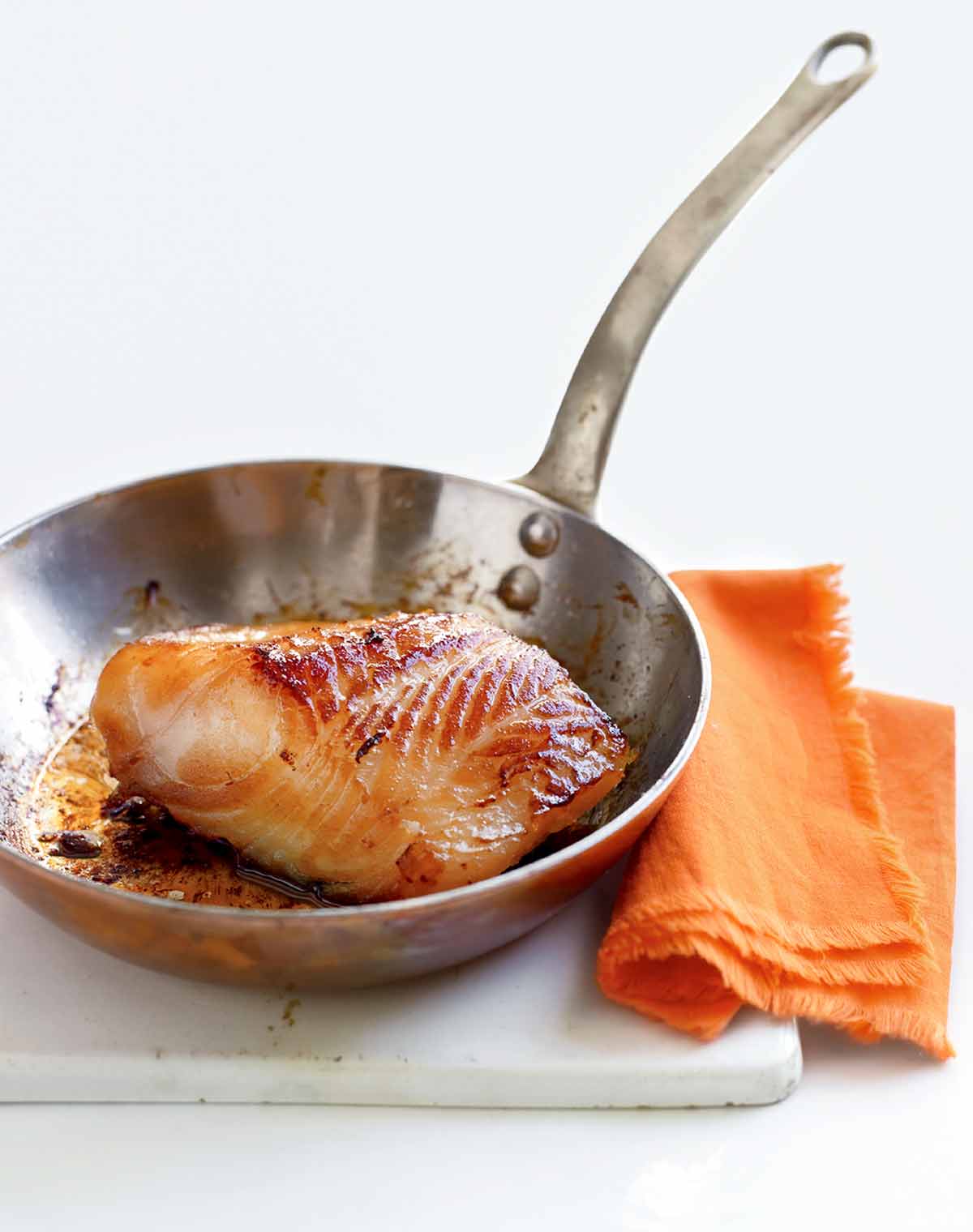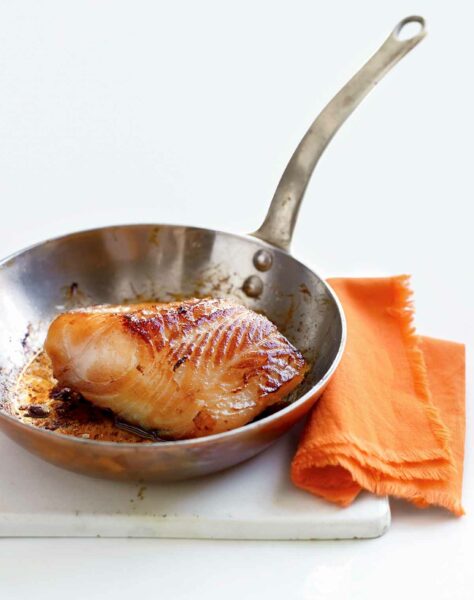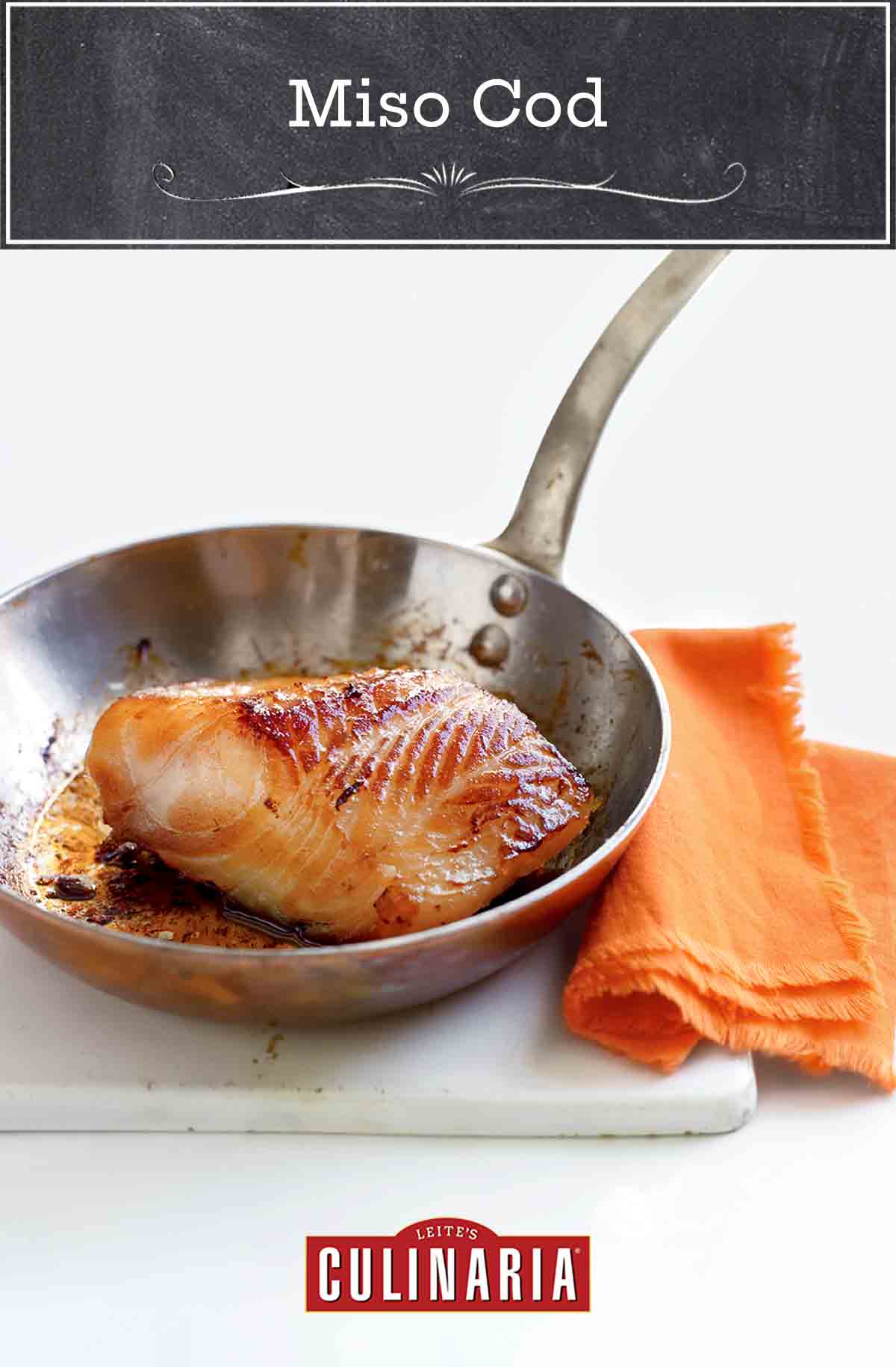
Restaurateur Nobu Matsuhisa first popularized this intriguing miso cod, which relies on a miso marinade for fish to lend an intensely rich, caramelized taste, and toothsome texture to an ordinary catch. Go ahead. Channel your inner Nobu.–Renee Schettler
Want to save this?
WHAT IS BLACK COD?
Not actually part of the cod family, and sometimes known as sablefish, black cod has white and fatty meat with a velvety and buttery texture. Cod is quite a bit firmer and leaner—black cod is moist, mild, and delicately textured. The closest equivalent is Chilean sea bass. It’s just about as fatty and works well for dry-heat cooking methods, like broiling, and grilling. Chilean sea bass has a sturdier, less flaky texture than black cod but will work just as well in an application like this.

Miso Cod
Ingredients
- 1 cup mirin
- 2 cups white or yellow miso paste
- 1 1/4 cups granulated sugar
- Four (6-ounce) black cod fillets, (may substitute Pacific cod or halibut)
- Canola oil
Instructions
- In a small saucepan over medium heat, warm the mirin. Don't allow it to boil. Add the miso and stir until completely incorporated, about 5 minutes.
- Pat the fish fillets dry. Place in a baking dish and generously slather both sides with the miso mixture. Cover the dish with a piece of plastic wrap. Refrigerate for at least 24 hours.
- Preheat the oven to 400°F (200°C). Lightly oil a rimmed baking sheet.
- Heat a nonstick skillet over medium-high heat. Uncover the fish and wipe off the excess marinade with paper towels. Add the fillets to the hot pan and sear until golden brown and caramelized on the bottom, 30 seconds to 1 minute. Be careful, as the fish can scorch and blacken quickly because of the sugar in the coating.
- Move the fillets to the prepared baking sheet, carefully turning them seared side up. Bake until the fish is cooked through and flakes easily, about 7 minutes.
- Arrange the fillets on a platter or individual plates and serve immediately.

Explore More with AI
Nutrition
Nutrition information is automatically calculated, so should only be used as an approximation.
Recipe Testers’ Reviews
Frankly, I didn’t expect this dish to be as delicious as it turned out to be. Upon tasting the marinade paste, my husband wasn’t impressed and my thoughts were that it was okay but not fabulous. Were we in for a surprise.
After the cod was marinated for 24 hours, the excess marinade rubbed off, the fish seared until caramelized (about 2 minutes), and then baked for just over 6 minutes, wow!
The caramelized bits that fell off were my favorite part of the whole thing. They were amazing. It’s true that the fish actually cures, as evidenced by the change in texture. The fish itself was very flavorful. If you want to try fish “candy” or fish “bacon” (in a good way), maybe try this with a thin fish such as sole so the entire thing caramelizes. You can bet I’ll be trying that.
I first had this dish at Nobu in NYC. Then I made it at home using Nobu: The Cookbook. This version of the recipe works very well and is a convenient variation to Nobu’s original recipe since you marinate the cod for only 24 hours rather than 3 days.
I wasn’t able to find black cod in my market so I substituted a nice thick Pacific cod. This worked very well—the flavor was quite comparable to Nobu’s version and the fish turned out nice and flaky. Baking time was several minutes longer than 7 minutes, most likely due to the thickness of the cod.
This is a simple and elegant fish recipe that requires relatively little work. I love ordering miso cod in restaurants, and it’s nice to have a recipe for it so I can replicate the dish at home.
The only amendment I’d make would be to use a little bit less sugar in the recipe, perhaps cutting down to 3/4 cup or so, depending on your taste. Do indeed pay attention to the fish while cooking—the sugar does cause the fish to blacken quickly.
I served this with some steamed brown rice and roasted broccoli, and it made for a nice light and healthy meal.
I had the original miso-marinated black cod at Nobu back in the ’90s when the dish was first invented and I still think of the experience with fondness. The sweet-salty miso marinade wasn’t overpowering or even obvious but was an excellent counterpart to the rich unctuousness of the fish. I’ve had this at other places since, but Nobu did it best. So of course I had to test this recipe out.
I had to make a few adjustments. There was no black cod to be found at my local fish market and I just couldn’t bring myself to purchase the endangered Chilean sea bass/Patagonian toothfish, so I settled on good old North Atlantic cod. All they had were fillets, so there was no skin for me to sear as was the case with the original. I also had a big bucket of red miso and was too lazy to go out to the Asian grocery for white or yellow miso. As red miso is saltier than the white/yellow kinds, I used only half of what was recommended in the recipe. I ended up putting the raw fish directly into a 400°F oven on greased foil for 13 minutes. The fish turned out much firmer than regular oven-baked cod—almost like it had been dry-cured. The marinade had done its job and drawn out a lot of moisture from the fish. It was a little salty for my taste though, so next time I’d make sure to wipe off the majority of the marinade, then moisten another paper towel to get the rest.
Great recipe—I tried it again with whole mackerels and got equally delicious results.
Extremely simple and tasty recipe, perfect for a weeknight. For those that love the taste of fish, this is perfect as its seasoning doesn’t overwhelm the fish. I’d even think that it’d be delicious with a steak fish such as shark.













I’m sorry to be critical, but my neighbor gave me a serving of miso cod – so buttery and melt in your mouth. I was so wanting to recreate it, and I followed your recipe step by step (I am not a novice ).
The cod was dry with only a minimal taste of the marinade, so I don’t know where I went wrong.
I think saute and baking was too much. Next time won’t wipe off all of the marinade and opt for roasting only.
I’m sorry to hear that this wasn’t a success for you, Jeana. It is easy to overcook fish, particularly because the thickness of the fillets varies. I wouldn’t recommend skipping the searing step, as the caramelization of the sugar adds a lot of flavor, but you could definitely pull the fish out of the oven after 4 minutes and see if it’s done to your liking.